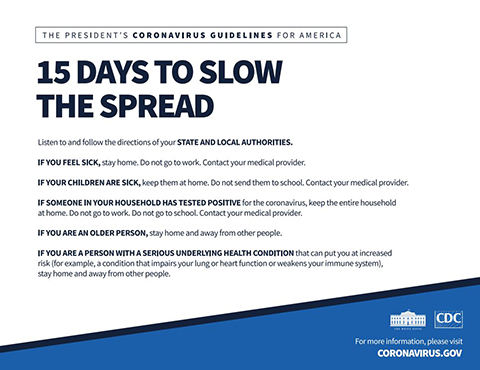
by Charles Bonniwell | Oct 22, 2021 | Feature Story Bottom Left
 Yes it was on Friday the 13th, a day steeped in mythology as a day of ill omens, in March of 2020, that President Donald J. Trump speaking in the White House Rose Garden, declared a national emergency that could free up $50 billion to help fight the pandemic and said that he was empowering the secretary of Health and Human Services to waive certain laws and regulations to ensure that the COVID-19 virus can be contained and patients treated.
Yes it was on Friday the 13th, a day steeped in mythology as a day of ill omens, in March of 2020, that President Donald J. Trump speaking in the White House Rose Garden, declared a national emergency that could free up $50 billion to help fight the pandemic and said that he was empowering the secretary of Health and Human Services to waive certain laws and regulations to ensure that the COVID-19 virus can be contained and patients treated.
“To unleash the full power of the federal government … I am officially declaring a national emergency,” Trump said.
“Two very big words,” he added.
Yes, they were and marked the beginning of the end to his presidency. The concept was to institute on a state-by-state basis lockdowns, mask mandates, and social distancing so that COVID-19 cases would be spread over a longer period so that ICU beds and ventilator machines would not be overwhelmed. All we had to do was go on a stay-at-home vacation for 15 days and all would be well. Approaching the two-year anniversary of that declaration we cannot be amazed at our overwhelming naiveté.
The result was a long-term worldwide recession, the loss of personal freedom, and liberty throughout the once called “Free World” from Italy to Australia, and the imposition of the “dictatorship of the public health bureaucracy.” If Karl Marx had only realized that the overthrow of democracy and capitalism did not require a bloody revolution but simply a public health mandate, we could have saved tens of millions of lives. In China, the apparent source of COVID-19, and the only remaining major country with a communist government, perhaps they did. They closed the city of Wuhan, China, from the rest of China but opened Wuhan up to the rest of the world. No COVID-19 recession for China but a recession for the rest of the world. Brilliant!
Of course, Trump was not the only politician to egregiously suffer due to that fateful Friday the 13th. Democrat New York Governor Andrew Cuomo initially rode the COVID-19 wave to great adulation, even garnering an International Emmy for his daily COVID briefings. In the end, however, he had to resign in disgrace in part from of the discovery that his dictates that nursing homes had to take in contiguous COVID-19 patients cost thousands of lives, which he fraudulently tried to hide. The coup de grâce came with the revelation that the so-called “LuvGov” was, in fact, a serial sexual harasser.
But what if Trump had ignored the advice from ever contradicting Dr. Anthony Fauci and the highly political Center for Disease Control and Prevention, and rode through the Ides of March doing nothing but shepherding through the development and distribution of vaccines for COVID-19. The one European country that ignored all of the lockdown mandates and impingements on civil liberties was surprisingly, Sweden, headed by the Swedish Social Democratic Party. From the beginning of the COVID-19 pandemic, the Public Health Agency, Folkhälsomyndigheten, embarked on a de-facto herd immunity approach, allowing community transmission to occur relatively unchecked. There were no mandatory measures taken to limit crowds on public transport, in shopping malls, or in other crowded venues, while recommending only a limit of 50 people for gatherings. Sweden’s mortality rates were lower than the European Union and the United States and its economy prospered.
In America, states like Nebraska, Wyoming, and Florida, which limited and quickly lifted COVID-19 restrictions appear to have weathered comparatively well when put up against highly restrictive states such as New York and California. Colorado, under Governor Polis, took a somewhat middle ground and at least did not go with the Draconian measures adopted by states such as Michigan, under the leadership of Governor Whitmer. In Denver we did get to see up close and personal the hypocrisy of the political elites when Mayor Hancock was at DIA texting to city employees not to travel over the Thanksgiving holidays, while he was heading to Texas and Mississippi to spend the holidays with family.
Was it all worth it? The autocrats and authoritarians and their admirers on the left and right will tell you it was. They certainly learned how easy it is to cower and control a populace. But at least for some the lesson learned is that next time they tell us the equivalent of it is just “15 days to flatten the curve” we know what they mean. It is time to again destroy liberty and freedom for as long as they can possibly get away with it.
— Editorial Board

by Charles Bonniwell | Sep 27, 2021 | Feature Story Bottom Left

Golden Rule: Phil Anschutz, Colorado’s wealthiest man.
The Colorado Republican Party met down in Pueblo for its fall meeting to consider whether to opt-out of the state run primary. The prominent Democrats had funded statewide referendums called Propositions 107 and 108 back in 2016, which made for Presidential primaries (107) and for open primaries for all others partisan elections (108) whereby unaffiliated voters would receive ballots from both parties and could choose one.
Similar measures had been passed in California and Utah, which mandated acceptance by the parties. Such mandates were found to be unconstitutional in federal courts so this time the provision was made where a political party could opt-out provided 75% of all its State Central Committee (the “SCC”) voted every two years in the fall to do so. Because of its extraordinary high percentage of all members, not just those voting, opting out is almost impossible.
Does this pass constitutional muster? Not according to virtually everyone from conservative legal scholar John Eastman to the liberal Legal Director of the Colorado ACLU Mark Silverstein. A group of grassroot Republicans who are members of the SCC (including the publisher of this paper) began touring the state to convince fellow members of the SCC to vote for opt-out of Proposition 108 at the fall meeting.
The merry band of grassroot activists did not do so because they thought they could achieve the nearly impossible task of getting 75% of all the SCC members to opt-out. In fact, 75% of all the members seldom even attend the fall meeting. The activists did so to get the leadership to act on the issue and bring suit in federal court to determine once all for all the unconstitutionality of Proposition 108.
Somewhat improbably the campaign caught fire and began to attract backers across the state. The Republican SCC is composed of 520 members which includes all state House and Senate legislators who are Republicans as well as the Republican Chair, Vice Chair, and Secretary of each of the 64 counties, as well as bonus members from the more populated counties.
Adherents for the opt-out included State Representatives Dave Williams, Matt Soper, Patrick Neville, Stephanie Luck, and Ron Hanks, former U.S. Congressman Tom Tancredo, Republican National Committeeman and radio host Randy Corporon, State Party Vice Chair Priscilla Rahm, and State Party Secretary Marilyn Harris.
But then came the counterattack from the Republican Party establishment who have controlled the Republican Party for over 20 years, and who dislike the grassroot Republicans more than the farthest left Democrats. The Colorado Republican Party has been, and is, controlled by one person, the state’s richest man, billionaire Phil Anschutz. Very few grassroots Republicans were ever actually aware of this fact.
Anschutz is the owner of the Broadmoor Resort in Colorado Springs, among many other business enterprises, including the NHL’s Los Angeles Kings and Anschutz Entertainment Group (AEG). He also controls the Colorado Springs Gazette newspaper and the blog sites Colorado Politics and the Denver Gazette. He is also rumored to be the biggest contributor to the Denver free market think tank, the Independence Institute, which in turn controls Complete Colorado a news aggregator.

The Discovery: Grassroots Republicans discover that Phil Anschutz is the man behind the curtain in Republican politics.
Anschutz never publicly expresses his political views and works behind the scenes through layers of intermediators. It is believed that he is not a Trump fan, and he is what was once called a “Rockefeller Republican.” His hires for editors and reporters at Colorado Politics and Denver Gazette are almost all left of center liberals and mostly laid off former Denver Post employees. His publications regularly attack grassroot politicians like former State House minority leader Patrick Neville while writing endless puff pieces on moderate Republicans like two-time failed gubernatorial candidate Bob “Both Ways” Beauprez.
The content of his publications tends to be almost no different than The Denver Post except for occasionally having moderate Republicans write opinion pieces. It is believed he has come to accept Democrat hegemony over the state governments of California and Colorado, where most of his business enterprises are located. He has figured out how to have his businesses thrive in such environments.
He clearly didn’t like the opt-out idea and all of a sudden, every one of his publications went on the attack and opposed the opt-out. Even though the Independence Institute’s Jon Caldera is not a Republican and now votes in Democrat primaries, he wrote an editorial condemning the opt-out and then emailed pleas to 520 members of the Republican SCC to vote no on the opt-out. The same for 710 KNUS host Jimmy Sengenberger who has been financially supported by Anschutz organizations. Anschutz even had the Colorado Gazette issue a scathing editorial on the eve of the Republican fall meeting condemning the opt-out vote.
In the end, the opt-out vote failed by a 60% to 40% margin of those attending the fall meeting. It was short of the required 75% of all members of the entire SCC. Ultimately, however, the grassroots won. They were able to get over 75% of the members to attend the fall meeting forcing the State Chair Kristi Burton Brown to even have a vote. Following that failed vote a motion and a resolution were passed almost unanimously demanding the party be a plaintiff to a federal lawsuit to overturn Proposition 108 and set up a separate fund to support such a lawsuit.
Anschutz won the opt-out battle but lost the war. Undoubtedly, Anschutz will try to scuttle the lawsuit too, but it is not clear he will be able to do so. Perhaps, more importantly grassroot Republicans have been able at long last to pull the curtain aside and see who their “Wizard of Oz” opponent really is.

by Glendale Sports Center | Aug 27, 2021 | Feature Story Bottom Left
by Claudia Morlan, Sr. Director of Communications, YMCA of Metro Denver
 “As an international student, winter holidays were often challenging. I was far away from friends and family. I often felt homesick and isolated. A friend from college invited me to spend my first Thanksgiving with her family. They opened up their home to me like I was family, even though my own was far away in Jordan. It’s now my responsibility to treat newcomers with the same hospitality. My hope is that people will experience the same kindness that made me feel like I belonged.”
“As an international student, winter holidays were often challenging. I was far away from friends and family. I often felt homesick and isolated. A friend from college invited me to spend my first Thanksgiving with her family. They opened up their home to me like I was family, even though my own was far away in Jordan. It’s now my responsibility to treat newcomers with the same hospitality. My hope is that people will experience the same kindness that made me feel like I belonged.”
Fairouz A. describes this story as part of Belonging Begins with Us, a partnership with organizations across the U.S. to create a more welcoming nation where everyone belongs.
Belonging Begins with Us is also the theme of Welcoming Week at YMCAs this year, including the YMCA of Metro Denver. During Welcoming Week, September 10-19, 2021, we recognize that there are many more things that unite us as neighbors and citizens than divide us. We can all play a role in making sure everyone feels safe and welcome in our community.
What can you do to foster a more welcoming place? Here are five easy steps:
- Read a book written by or about an immigrant’s story.
- Learn to say “hello” in a different language and try it out with a friend.
- Share a story on social media about your family’s heritage or immigrant story and invite others to share.
- Support an immigrant-owned business.
- Try a recipe from a cookbook like the “The Taste of Belonging” by Immigrant Pathways Colorado.
Whatever you choose to do, remember finding points of connection and sharing experiences help create strong, supportive communities. Learn more about Welcoming Week at denverymca.org/new-american-welcome-center.

by Glendale Sports Center | Jul 23, 2021 | Feature Story Bottom Left
by Katie Canfield, Community Relations Manager
 As a volunteer, you don’t always know the impact you have on the people around you. To the Roberts Family, they will never forget the impact Coach Robert Diaz had on their son Jack. Serving as a volunteer baseball coach for the YMCA of Metro Denver for five seasons, Coach Diaz left an indelible mark on many young athletes.
As a volunteer, you don’t always know the impact you have on the people around you. To the Roberts Family, they will never forget the impact Coach Robert Diaz had on their son Jack. Serving as a volunteer baseball coach for the YMCA of Metro Denver for five seasons, Coach Diaz left an indelible mark on many young athletes.
Crediting Diaz for “including and encouraging” their son Jack, Sasha Roberts says Diaz accepted him for “who he is and met him at his level.” She praised Diaz for giving their Park Hill baseball team “a safe space to develop and grow and ‘develop a love for the game.’”
It was a year of limited in-person connection, but 2020 was also a time when many stepped up their effort to help their communities through volunteering.
For East High School Student Aitiana Wilson, volunteering for the YMCA’s Beyond Hunger food pantry program was her salvation.
“I was surrounded by negative news … and decided to go out and help someone,” said Wilson, who became a YMCA volunteer during her junior year of remote learning. At the weekly food distribution, she says, “I started talking to people, built connections and it felt great. I want to do it as often as I can.”
As we are, once again, safely and freely connecting with friends, family and our communities, there are so many opportunities to volunteer.
Consider joining the volunteers at the Southwest YMCA who are assembling and distributing bags of fresh groceries to families in need. The YMCA distributed 220,000 pounds of food to 23,000 individuals in 2020 and the need has not abated.
Across the city, nearly 16,000 youth athletes are participating in basketball, baseball, lacrosse, tennis, soccer, and tennis leagues under the direction of trained YMCA staff. But they couldn’t do it without the help of dedicated volunteer coaches assisting in teaching the fundamentals of the game and good sportsmanship.
Or join “Team Y” at neighborhood events this summer and fall including hosting the YMCA Kids Zone at the Littleton Western Welcome Week (Aug. 21), South by Southeast Community Festival (Aug. 21), or hosting the Kids Zone at the Arvada Harvest Festival (Sept. 10-12).
As Coach Diaz attests, “Coaching at the Y has been one of the best service experiences of my life. Through giving, I have received so much in return.”
There are so many opportunities to contribute in your community. Visit denver ymca.org/volunteer and learn how you can support a program or event near you.

by Glendale Sports Center | Jun 25, 2021 | Feature Story Bottom Left
 by Sandy McClain, Senior Director of Human Resources, YMCA of Metro Denver
by Sandy McClain, Senior Director of Human Resources, YMCA of Metro Denver
“My hope is that after years of summer camp at the YMCA, Ten can come back as a counselor someday,” said Giovanna, whose son Tennyson attends YMCA summer camp where he is “surrounded by awesome staff that make him feel special while having amazing experiences.”
More than 1,400 youth are in YMCA summer day camp this summer at locations across the Denver Metro area. After a difficult school year, with remote learning and isolation from friends, it’s an exciting summer for kids to get back to being kids.
Camp is the place where youth make friends and build character. They are part of a community, a safe place to learn how to be more independent but also how to contribute to a group as they engage in physical, emotional and educational activities.
Camp teaches self-reliance, a love of the outdoors and where kids foster leadership skills. Caleb J. attends YMCA Day Camp and his camp counselors can’t say enough about his leadership skills in welcoming in new kids while his adoptive mom says the skills he’s learned at camp extend to his responsibilities at home.
Those skills learned as a camper at the Y can be taken into any future job and career. The Y gives youth early work experience, employing 61,000 college-aged young adults at camps across the country each year. Further, a summer position at the Y can be a launching pad for a long-term career within the YMCA. YMCA of Metro Denver staff members Giovanni Forrest and Claudia Nunez-Medina were counselors at Camp Chief Ouray at YMCA of the Rockies and today serve in roles in our Solution Center and at our Downtown YMCA. Co-workers Abby Kenner and Darren Krische began their Y careers as day camp counselors together at the YMCA and today are leaders for the Youth Development team.
While summer is the busiest season, the YMCA of Metro Denver offers both seasonal and year-around career opportunities. If you want to make a difference in a child’s life and gain lifelong experience, join us. Visit denverymca.org/employment.

by Glendale Sports Center | May 26, 2021 | Feature Story Bottom Left
 by Elizabeth Bravman, Nutritionist, Healthy Heart Ambassador, Cycling Instructor, YMCA of Metro Denver
by Elizabeth Bravman, Nutritionist, Healthy Heart Ambassador, Cycling Instructor, YMCA of Metro Denver
We all know that WHAT we eat is very important for our overall health. But did you know that thinking about WHY and HOW you eat can bring your wellness to a whole new level? Practicing Mindful eating can help us do just that.
The opposite of “mindful” eating is “mindless” eating. What is that?
- Have you ever eaten a quick breakfast in the car?
- Eaten lunch while doing work at your desk or dinner in front of the TV?
- Snacked right from a large bag or container while you scrolled through your phone?
If you answered yes to any of these questions, then you have mindlessly eaten. You are not alone. Most Americans practice some sort of disconnected eating every day. Food is part of our culture, and we have a distorted view of portion sizes. Plus, we love to multitask which is the perfect recipe for mindless eating. These habits can lead to overeating, weight gain and serious health risks.
Mindful eating can help us avoid the pitfalls of mindless eating and bring us back in touch with how and why we eat.
Stay connected by pausing and asking these three why and how questions:
- Am I truly hungry? Seems like an easy question but since we live in a toxic food environmen
 t that is constantly sending us external messages about eating, it can be difficult to tap into those internal cues of hunger. Sometimes it’s a clock telling us to eat, we see or smell food or we are in a social setting, and we eat regardless of being hungry.
t that is constantly sending us external messages about eating, it can be difficult to tap into those internal cues of hunger. Sometimes it’s a clock telling us to eat, we see or smell food or we are in a social setting, and we eat regardless of being hungry.
TIPS: Put sticky notes near your fridge, pantry, plates/bowls or silverware with this question written on it. Set up an alert in your phone that asks you this question. Often hunger can be confused with thirst, have a large glass of water while trying to decide!
- Am I satisfied? Satisfied — not full or stuffed. It takes about 20 minutes for hormones in your body to signal your brain that you are full. It’s best to stop eating when you first start to feel satisfied.
TIPS: Check in with yourself about halfway through your meal to see how you may be feeling on the satisfied scale. Take your time! Try placing your silverware down in between bites, use your non-dominant hand or chopsticks to eat to help slow you down. Set a timer for 20 minutes. If you finish before then and you think you might still be hungry, get up from the table, do dishes or take a walk, before checking in with yourself to see if you still might be hungry. If the answer is yes, then honor your hunger and eat more!
- Am I eating because I am sad, bored or stressed? Often, we eat because we are feeling something else and not hunger. Addressing these feelings directly will help avoid emotional eating.
TIPS: If you notice you want to eat because you have one of these occasional emotions, a swap can help you process the emotion. If you want to eat because you are bored some great swaps are going for a walk, listening to a podcast, calling/texting a friend or cleaning. A swap for stressed emotions may be exercise or venting to a friend. Sad or lonely? Call/text a close friend, journal, or try a warm bath or a funny TV show. It is important to note that if these emotions are intense and/or frequent, seek support from a health professional.
- Am I eating with distractions? With distractions we miss our internal cues of satiety and may overeat. Remove technology, work, reading materials, or other distractions while eating. Be present and focus on enjoying your food.
TIPS: Sticky notes or alerts on your phone to put away all distractions can help. Saying a blessing over your meal or acknowledging where your food has come from and how many hands were involved in bringing it to your table can also bring your focus to eating.
- Am I setting myself up for success with appropriate portion sizes? Portion sizes should not matter if you are paying attention to your internal cues but… we’re human and studies show that large portion sizes push people to overeat!
TIPS: Learn average portion sizes for you. Don’t eat directly out of containers or bags, portion into smaller plates and bowls. Using smaller plates and bowls will make you feel like you have more. Don’t forget to check in with yourself — some days the average portion size might be too much or not enough depending on what is going on in your life!
- Am I enjoying my food? Food should taste good, and eating should be enjoyable!
TIPS: Sit down and simply observe your food — its textures, colors, and smells. Chew slowly, noticing flavors and sensations. If you are in a group, it’s fun to experience this together, making observations and comparisons. Journal about your food. With children, it’s great to play games where everyone closes their eyes and describes their first bite in detail.
The act of pausing and bringing your attention to why and how you are eating may open your eyes to certain aspects of your eating that can be improved. Be curious in a non-judgmental way. Notice your answers and consider the factors influencing you.
Be gentle on yourself as you start to practice thinking about why and how you eat. Try to incorporate just one question into your day and make sure it’s one that feels doable to you right now. Try something like: “I will not use any technology or have any distractions during lunch on Tuesdays and Thursdays this week” or “I will not eat chips right from the bag on Friday nights.”
This is a lifelong practice with the goal of simply becoming more mindful at eating. The more you practice, the easier it gets.
If you need any nutritional support, the YMCA of Metro Denver’s nutrition team can be contacted through denverymca.org.

 Yes it was on Friday the 13th, a day steeped in mythology as a day of ill omens, in March of 2020, that President Donald J. Trump speaking in the White House Rose Garden, declared a national emergency that could free up $50 billion to help fight the pandemic and said that he was empowering the secretary of Health and Human Services to waive certain laws and regulations to ensure that the COVID-19 virus can be contained and patients treated.
Yes it was on Friday the 13th, a day steeped in mythology as a day of ill omens, in March of 2020, that President Donald J. Trump speaking in the White House Rose Garden, declared a national emergency that could free up $50 billion to help fight the pandemic and said that he was empowering the secretary of Health and Human Services to waive certain laws and regulations to ensure that the COVID-19 virus can be contained and patients treated.






